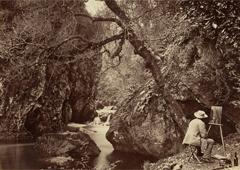Hide/Seek: Difference and Desire in American Portraiture
Unitl Feb. 13, 2011
National Portrait Gallery
Called “an outrageous use of taxpayer money” by incoming House Majority Leader Eric Cantor (R-Va.), “Hide/Seek: Difference and Desire in American Portraiture” at the National Portrait Gallery is the first major American art exhibit to focus on homosexuality since a 1989 Corcoran exhibit, which Congress forced to close on grounds of “indecency.”
“Hide/Seek” reflects society’s dynamism regarding romantic and sexual norms. Portraits of famous homosexuals from Walt Whitman to Ellen DeGeneres are highlights of the exhibit, as well as paintings by Jasper Johns and Robert Rauschenberg, whose relationship in the 1950s and 1960s was an open secret. Georgia O’Keefe’s delicate and blushing flower paintings — subliminally sexual — are another major feature of the exhibit.
But the exhibit is marred by controversy and is as criticized for the works missing from the exhibit as for those that are present. Complaints by Catholic groups and members of Congress spurred the Smithsonian to remove a video by David Wojnarowicz that showed ants crawling on a crucifix. Complaints came not only on account of the depiction of the crucifix, but because of the inclusion of “male nudity.” In turn, accusations of censorship and homophobia have been leveled at Congress, in many ways overshadowing the exhibit’s message of tolerance and justice. Nonetheless, “Hide/Seek” is not only an exquisite exhibit, but also an interesting commentary on modern censorship.
Gods of Angkor: Bronzes From the National Museum Of Cambodia
Until Jan. 30, 2011
Sackler Gallery
For an obscure subject matter, “Gods of Angkor: Bronzes From the National Museum of Cambodia” has received a great deal of hype. Bronze sculptures spanning 1600 years of Cambodian history are on display at the Smithsonian’s Sackler Gallery.
The result of a partnership between the National Museum of Cambodia and the Smithsonian, figures from Buddhist and Hindu worship, as well as bronze devotional objects have been sent to Washington, D.C., in exchange for some of the Smithsonian’s preservation technology. The exhibit gives museum goers a closer look at Cambodia’s distinct style of bronze casting. Beautiful and delicately crafted, these ancient bronzes are a rare glimpse into ancient Cambodian culture and religion.
The Pre-Raphaelite Lens: British Photography and Painting, 1848-1875
Until Jan. 30, 2011
National Gallery of Art
About 100 photographs and 20 watercolors line the walls of the National Gallery’s “The Pre-Raphaelite Lens: British Photography and Painting, 1848–1875”
In late 19th-century Britain, the Pre-Raphaelites were a small and often overlooked group of painters and photographers who wanted to return to the purity of art before high Renaissance painter Raphael. These early avant-garde artists were fascinated by the vivid detail and exactitude of the newly emerging medium of photography. Consequently, their beautiful landscapes and portrait photographs were major influences on contemporary painters.
In spite of the Pre-Raphaelite school’s strict interpretation of the medium, the photographs are often surreal and ethereal. Unsurprisingly, this fantastical element is seen most clearly in the works of Charles Lutwidge Dodgson, better known by his pen name Lewis Carroll.
Pale, Ophelia-like women decked in flowers and sinister Gothic maidens speak to the fact that these works were somewhat anachronistic and nostalgic for earlier naturalism. The new medium of photography was in some ways adapted to very traditional themes; thus “The Pre-Raphaelite Lens” shows the strange marriage of old and new that took place in mid-19th-century England.








